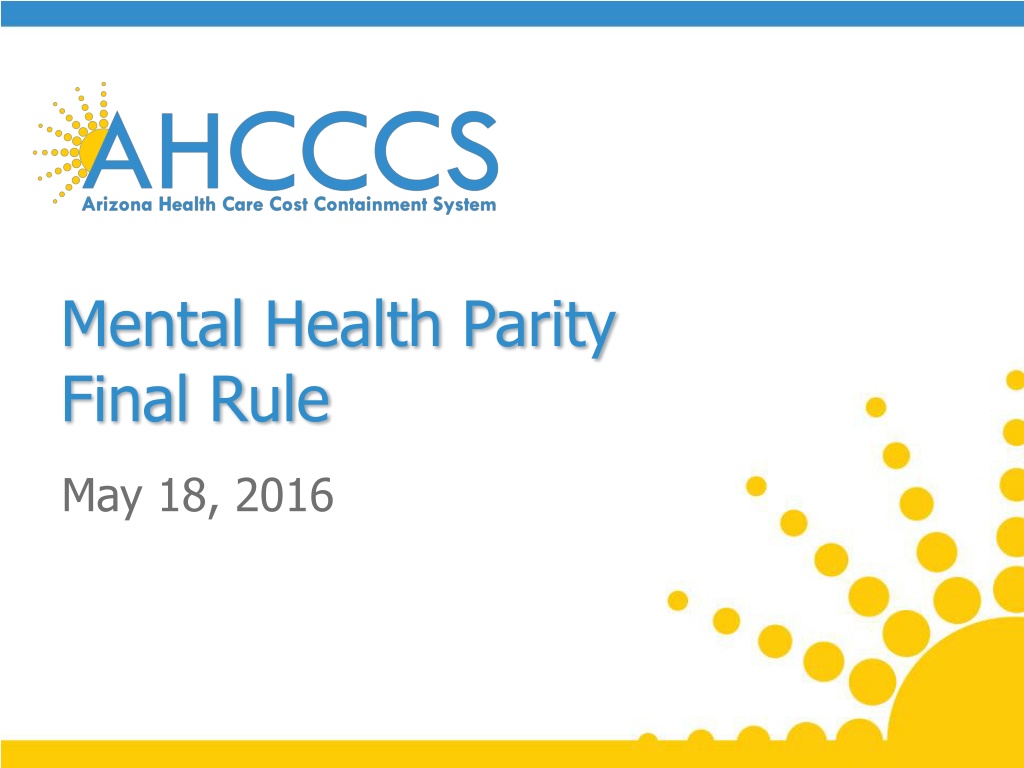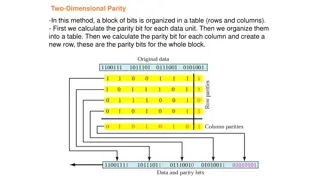Understanding the Mental Health Parity Final Rule of May 18, 2016
The Mental Health Parity Final Rule of May 18, 2016 aims to ensure that financial and treatment limitations on Mental Health and Substance Use Disorder benefits are no more restrictive than those applied to Medical/Surgical benefits. This includes analysis of financial and treatment limitations, quantitative treatment limits, and examples of how these limits are applied to different healthcare services.
Download Presentation

Please find below an Image/Link to download the presentation.
The content on the website is provided AS IS for your information and personal use only. It may not be sold, licensed, or shared on other websites without obtaining consent from the author. Download presentation by click this link. If you encounter any issues during the download, it is possible that the publisher has removed the file from their server.
E N D
Presentation Transcript
Mental Health Parity Final Rule May 18, 2016
Mental Health Parity Financial and treatment limitations on Mental Health and Substance Use Disorder benefits may be no more restrictive and applied no more stringently than to Medical/Surgical benefits
Financial Limitation Analysis Lifetime and Annual Dollar Limits o Limits on <1/3 of Med/Surgical benefits No limits permitted on MH/SUD benefits 1/3-2/3 of Med/Surgical benefits Average of Med/surgical limitations >2/3 of Med/Surgical benefits Apply the limit to MH/SUD without distinguishing between services or Include a limit on MH/SUD no more restrictive than on Med/Surgical Cumulative Financial Requirements No Separate limits o o o
Treatment Limitation Analysis Quantitative Treatment Limitations (QTLs) Non-Quantitative Treatment Limitations (NQTLs) Classifications o Inpatient o Outpatient Office Visits All other outpatient o Emergency o Pharmacy Can use tiered list
Quantitative Treatment Limits Quantitative Treatment limits include visit limits, inpatient day limits, and co-pays Must apply to substantially all (2/3) Medical/Surgical benefits MH/SUD limit must be equal to or less restrictive than the predominant limit
Quantitative Treatment Limits Inpatient Limited to 30 days for Med/Surgical Limited to 30 days for MH/SUD Table 1 Example of Quantitative Treatment Limit o Percent of classification subject to a limit Benefit/classification Medical/Surgical o Projected payment Percent of total costs Outpatient Specialist services limited to 50 visits (Med/Surgical) PCP services are unlimited (Med/Surgical) Physical Therapy visits limited to 20 visits Occupational Therapy limited to 20 visits Outpatient MH Services limited to 20 visits Inpatient Hospital $400x 100 100 o Inpatient total 400x 100 100 o Physician Services 150x 27 0 o Specialist Services 250x 46 46 Physical Therapy 75x 13.5 13.5 o Occupational Therapy 75x 13.5 13.5 Outpatient total 550x 100 73 o Emergency Services 100x 100 0 Emergency Services Unlimited for both Emergency total 100x 100 0 o
Non-Quantitative Treatment Limits NQTLs include medical management standards, formulary design, network tier design, provider admission and reimbursement rates, fail-first policies, and out-of-network access standards May not include NQTLs unless comparable standards are applied to medical/surgical benefits in the same category. NQTL standards may not be applied more stringently to MH/SUD benefits NQTL evaluation focuses on equal processes not necessarily equal outcomes
Non-Quantitative Treatment Limits Ex: MCO requires PA for all inpatient benefits. In practice, med/surgical benefits are routinely approved for 7 days while MH/SUD benefits are routinely approved for 1 day Ex: MCO applies concurrent review to inpatient care where high levels of variation (CV>.8) are present. In practice, this standard impacts 60% of MH/SUD benefits and 30% of Medical/Surgical benefits
Other Parity Provisions Availability of Information No Cost Exemption o Costs to be incorporated into cap. rates IMD Exclusion
Potential MCO Impacts Contracts will need to comply with mental health parity before October 2, 2017 Information and data necessary to perform the parity analysis (QTLs, NQTLs, Annual financial limitations)























